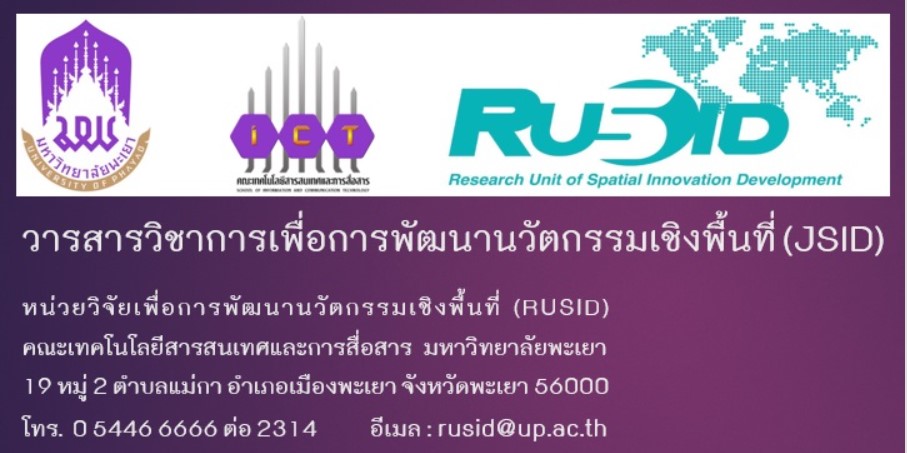การประยุกต์ใช้ระบบสารสนเทศภูมิศาสตร์สำหรับการประเมินที่ฝังกลบอย่างถูกหลักสุขาภิบาลในพื้นที่ฝั่งตะวันออกของจังหวัดพะเยา
คำสำคัญ:
การฝังกลบขยะมูลฝอย, การคัดเลือกพื้นที่, การวิเคราะห์แบบซ้อนทับบทคัดย่อ
การฝังกลบขยะมูลฝอยสามารถส่งผลกระทบทางลบหลายอย่างต่อสิ่งแวดล้อม หนึ่งในข้อพึงระวัง คือ การปนเปื้อนสู่แหล่งน้ำของน้ำชะขยะมูลฝอยหรือของเหลวที่ซึมผ่านขยะ ที่สามารถบนเปื้อนได้ทั้งน้ำใต้ดินและแหล่งน้ำผิวดิน นอกจากนี้ การฝังกลบนั้นยังใช้พื้นที่จำนวนมากซึ่งอาจกระทบต่อพื้นที่ป่าไม้ การอยู่อาศัยของสัตว์ป่าและอาจก่อให้เกิดความขัดแย้งในการใช้ประโยชน์ที่ดิน การศึกษาครั้งนี้มุ่งเน้นการประเมินหาพื้นที่เหมาะสมสำหรับการฝังกลบขยะมูลฝอยแบบถูกหลักสุขาภิบาลในพื้นที่จังหวัดพะเยาฝั่งตะวันออกโดยอาศัยการประยุกต์ใช้งานระบบสารสนเทศภูมิศาสตร์ ข้อกำหนดและมาตรฐานจากกรมควบคุมมลพิษถูกนำมาพิจารณาร่วมกันเพื่อการหาพื้นที่เหมาะสมสำหรับการฝังกลบขยะ ผลการศึกษาพบว่าพื้นที่ด้านฝั่งตะวันตกของจังหวัดพะเยามีความเหมาะสมมากที่ในการฝั่งกลบขยะ มีขนาดพื้นที่ประมาณ 637 ตร.กม. หรือประมาณ 398,380 ไร่คิดเป็นร้อยละ 16 ของพื้นที่ศึกษา ผลที่ได้จากการศึกษาเป็นข้อมูลที่ใช้สนับสนุนสำหรับการวางแผนและการตัดสินใจในการคัดเลือกพื้นที่สำหรับการฝังกลบขยะมูลฝอย องค์กรปกครองส่วนท้องถิ่นและหน่วยงานที่เกี่ยวข้องสามารถนำผลลัพธ์ที่ได้จากการศึกษาไปปรับใช้เพื่อเป็นแหล่งข้อมูลในการสนับสนุนและช่วยเหลือให้แก่นักวางผังเมืองหรือผู้มีอำนาจตัดสินใจในการทำความเข้าใจพื้นที่อย่างลึกซึ้ง
เอกสารอ้างอิง
กรมควบคุมมลพิษ. (2565). ข้อเสนอแนะแนวทางการแก้ไขปัญหาสถานที่กาจัดขยะมูลฝอยของเทศบาลเมืองพะเยา. กระทรวงทรัพยากรธรรมชาติและสิ่งแวดล้อม. สืบค้นจาก https://thaimsw.pcd.go.th/service/uploads/report-waste-file/337d73e0-160d-4085-8a78-6d040af9c4ce.pdf เมื่อ 15/11/2565
ภานุพันธ์ ไพฑูรย์. (2563). รูปแบบการจัดการขยะมูลฝอย โดยชุมชนมีส่วนร่วม เพื่อสร้างสังคมสุขภาวะ ตำบลท่าวังทอง อำเภอเมือง จังหวัดพะเยา. มหาราชนครศรีธรรมราชเวชสาร,4(1),11-29.
กรมควบคุมมลพิษ. (2552). การกำจัดขยะมูลฝอย แบบฝังกลบอย่างถูกหลักสุขาภิบาล (Sanitary Landfill). กระทรวงทรัพยากรธรรมชาติและสิ่งแวดล้อม. สืบค้นจาก https://www.pcd.go.th/publication/4995
กรมควบคุมมลพิษ. (2563). หลักเกณฑ์ในการคัดเลือกพื้นที่ การออกแบบก่อสร้างและการจัดการสถานที่กำจัดมูลฝอยชุมชน โดยการฝังกลบอย่างถูกหลักสุขาภิบาล, กระทรวงทรัพยากรธรรมชาติและสิ่งแวดล้อม; สืบค้นจาก https://www.pcd.go.th/garbage/หลักเกณฑ์ในการคัดเลือก-2.
กรมควบคุมมลพิษ. (2560). คู่มือ การวางแผนบริหารจัดการของเสียอันตรายจากชุมชนสำหรับผู้บริหารองค์กรปกครองส่วนท้องถิ่น, กระทรวงทรัพยากรธรรมชาติและสิ่งแวดล้อม. สืบค้นจาก https://www.pcd.go.th/wp-content/uploads/2020/06/pcdnew-2020-06-10_07-14-46_274861.pdf
Malczewski, J. (1999). GIS and Multicriteria Decision Analysis. New York: John Wiley & Sons, Inc.
สุภาวดี น้อยน้ำใส, ปิยะดา วชิระวงศกร. (2560). การประเมินพื้นที่ที่เหมาะสมสำหรับสถานที่ฝังกลบขยะมูลฝอยแบบถูกหลักสุขาภิบาลในจังหวัดอุตรดิตถ์โดยใช้ระบบสารสนเทศภูมิศาสตร์. วารสารมหาวิทยาลัยนเรศวร วิทยาศาสตร์และเทคโนโลยี, 25(3).77-88.
จุมพล วิเชียรศิลป์, ณัฐพล วงษ์รัมย์ และชลาวัล วรรณทอง. (2558). การใช้ระบบสารสนเทศทางภูมิศาสตร์เพื่อศึกษาหาพื้นที่ที่เหมาะสมต่อการฝังกลบขยะมูลฝอย: กรณีศึกษาอำเภอลำปลายมาศ จังหวัดบุรีรัมย์. รมยสารี, 13(2). 19-32.





